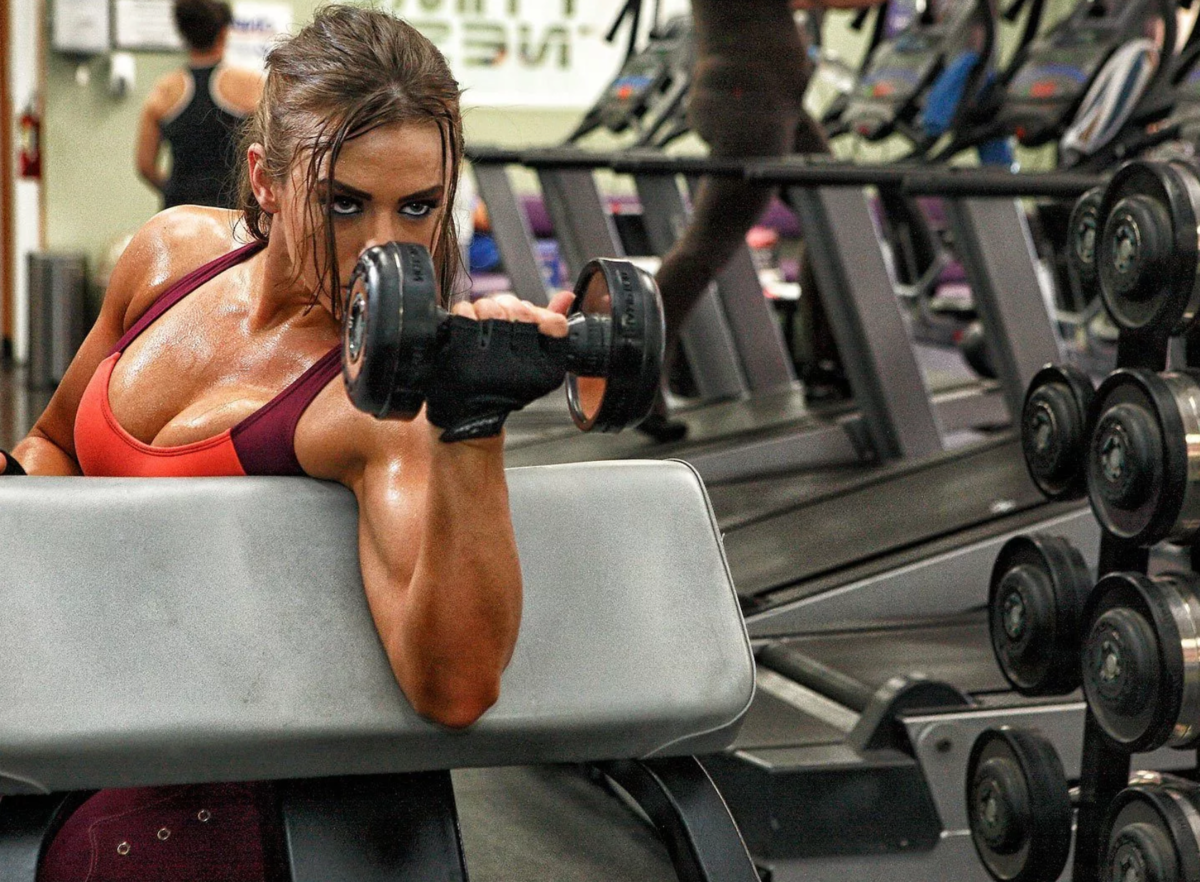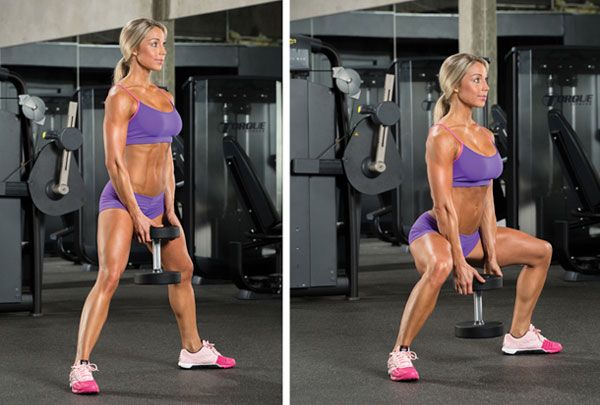Dumbbell Squats – Legs and Butt Workout for Beginners
The classic barbell squat technique can be difficult for the untrained athlete. For beginners, it is recommended to strengthen the muscles of the legs and buttocks with simple exercises. We’ll talk about just one of these – squats with small shells – and we’ll talk.
What muscles work?
Target groups:
- thigh muscles;
- buttocks;
- calf.
Indirect load is received by the press, the extensors of the spine. If the dumbbells are heavy, deltas, biceps, large chest are loaded. Exercise strengthens the stabilizing muscles, which are responsible for balance and coordination.
Benefits of the exercise
Qualitative work of the muscles of the lower body is not the only advantage of squats. Let’s consider others:
- development of strength characteristics of an athlete;
- complex study of the body: legs, back, abs;
- strengthening of joint tissues;
- can be used in home workouts;
- stimulation of the hormonal system;
- tightening problem areas: hips, buttocks, abs;
- high calorie consumption;
- safe execution (relative to classic barbell squats).
Due to its wide range of benefits, the arm squat is used in both men’s and women’s training programs.
The positive properties of the exercise appear only with regular performance and adherence to the technique.

Variations of squats and execution techniques
There are many options for performing squats with weights. We propose to consider the most effective and figure out for what purposes each of them is suitable.
Classic Double Dumbbell Squat
A good alternative to barbell squats. Depending on the depth of the lowering of the pelvis, you can shift the focus from the quads to the buttocks.
If a girl wants to work out the gluteal muscles, while squatting, she lowers her pelvis below the parallel of her hips to the floor. Men are advised to squat to a right angle at the knees so as not to take the load off their legs.
Technique:
- Stand up straight. Bend your lower back, look at an angle of 45 ° up. Feet – shoulder-width apart, socks look to the sides.
- Take the dumbbells and lower your arms freely at your sides.
- Take a deep breath and gently pull your pelvis back.
- Having reached bottom point, as you exhale, push the body up. In the upper phase, do not straighten your knees all the way. Otherwise, the payload will subside.
Features:
- while lowering the hull, make sure that your knees do not go beyond the line of the toes;
- do not strain the arm muscles;
- focus on the heels and the outside of the foot;
- do the exercise without pauses at the bottom and top points.
The number of approaches and reps is the same as when squatting with a barbell: for relief for girls – 3×15, for strength and volume for men – 3×8.
Plie squats
The advantage of this exercise is the accentuated study of the inner surface of the thighs and buttocks. Therefore, these squats are popular among the fair sex. Men use strength plie squats to strengthen adductors and joint tissues, which can improve deadlift and classic barbell squats.
Squatting is carried out by abducting the pelvis, rather than bending the body forward:
- Spread your feet wide and spread your toes apart. Bend your lower back and hold it in this position throughout the approach.
- Take one dumbbell and lower it in front of you, do not strain your arms.
- Inhale, pull your pelvis back.
- As you exhale, gently rise. In the upper phase, do not fully extend the knee joints.
Features:
- the lower you lower your pelvis, the more the buttocks will “turn on”;
- to keep the lower back arched, look up, at an angle;
- when performing, the knees should not converge inward and go beyond the line of the foot;
- the more you turn the feet to the sides, the better you use inner thigh.
Sumo squats
Novice athletes confuse “plie” and “sumo”. At first glance, it may seem that these are one and the same exercise. But in fact, there is a difference.

When performing a plie squat, the athlete tries not to tilt his back forward, which allows to stretch the adductor muscles of the thigh well. On the other hand, in sumo squats, the body is intentionally tilted forward to maximize the use of the gluteal muscles.
Front squats
The exercise simulates a squat with a barbell on the chest. The technique of lowering and raising the body is similar to simple squats. The only caveat is weight retention.
Many athletes flex their arms and lightly lean the dumbbells against the collarbones and the top of the chest. With this embodiment, the muscles of the arms are usually in tension. Therefore, if you are a beginner, we recommend you another way to hold the shells: press the dumbbells to the upper shoulder and trapezoid. This can relax your arm muscles a bit and shift the focus to the hips and buttocks.
Avoid the following technique mistakes:
- “rounding” the back;
- dumbbells too heavy;
- support on toes;
- sharp jerking movements of the legs.
Squats with dumbbells on the shoulders
The technique is similar with front squats, but differs in weight retention:
- Stand up straight. Take the dumbbells with a neutral grip (palms turned to the hips) and lift them to the shoulders.
- Press the dumbbells flat against the upper surface of the deltas, placing them vertically on the shoulder joints.
- Keeping the weight in this position, do slow squats.
When lowering the pelvis, do not bend too much forward, as your back muscles will try to maintain balance, which can lead to overstrain.
Scissor squats
This is a variation of lunges (also called lunges in place “). They emphasize the load on the gluteal muscles, therefore they are often used in women’s fitness programs:
- Stand up straight and take dumbbells. Straighten your shoulders.
- Step back with your left foot. The distance between the feet is about 70-80 cm.
- Keeping your back straight, inhale, pull your pelvis back and lower your body to a right angle at the knee joint of the “front” leg.
- Exhale and come back in a vertical position.
Features:
- do not “fill up” body forward, otherwise a dangerous load will fall on the knee of the front leg;
- “back” foot rest on the toe, “front” – in the heel;
- do not strain your shoulders and arms.
Bulgarian squats
The technique is similar to scissor squats:
- Turn your back to the horizontal bench and take a step forward.
- Take the dumbbells and lower them freely down to the sides.
- Take your left leg back and place her toe in the bench seat.
- Keeping your back straight, do squats until your right thigh is parallel to the floor.
The advantage of the exercise is that the body weight is shifted by 70-80% to the front leg, which maximizes the load on the thigh muscles. Also, the pluses include a deep amplitude of squats.
Bulgarian squats require an athlete to have developed stabilizing muscles and a good sense of balance. Therefore, if you are a beginner, we recommend doing the exercise without dumbbells.
Squats with lifting shells up
Used, as a rule, by athletes- strength athletes to improve results in the main weightlifting elements: snatch, clean and jerk and take weight on the chest. This option helps to further strengthen your back, shoulders and arms:
- Stand up straight. Take the dumbbells with a straight grip (palms facing you) and press them to the front of the thighs.
- Keeping your back straight, inhale and sit down. Raise your arms at the same time as the squat. At the bottom, the pelvis should be as low as possible, and the dumbbells should be strictly above the head.
- Exhale and straighten. Lower the shells to your hips.
Features:
- do not make sharp tosses, smoothly lift the weight over your head;
- do not tilt your torso forward too much, otherwise you risk falling over;
- push from the bottom position from the entire foot, not from the toes.
Using squats in fitness
Due to the many variations, squats with weights can be used in different training programs: for weight, for relief, for increasing strength indicators. But it is a mistake to believe that only with squats you can achieve good results.
The muscles adapt to monotonous movements and cease to perceive the load. Therefore, experienced athletes always combine these elements with other lower body exercises. Let’s list the main ones:
Build your lesson plan around 1–2 basic exercises and a few auxiliary ones. We also recommend training your shoulders with your legs on one day. A rough plan for a male beginner:
- Warm-up: 10 minutes of cardio.
- Smith Machine Squats – 3 x 8.
- Front Squats – 3×12.
- Leg press in the hack simulator – 3×8.
- Seated leg extension – 3×12.
- Arnold press (front and middle deltas) – 3×12.
- Layout through the sides (middle bundle of deltas) – 3×12.
- Reverse assignments in the slope (back bundle of deltas) – 3×12.
- Standing calf raises – 3×12.
Some tips for beginner athletes:
- Soft running shoes are not suitable for squats, it is better to buy special shoes – weightlifting.
- If the wrist grip is weak , use the pull-up straps to hold the dumbbells.
- If you have knee problems, consult your doctor and use elastic knee bandages.



